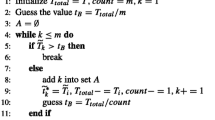Abstract
In a wide area campus, a university provides Wireless Local Area Network (WLAN) for users to connect to the Internet. Most users take advantage of this WLAN benefit by using their laptops. However, the number of smart phone users is growing fast. Since a smart phone is able to get an Internet connection using WLAN, users can use their smart phones without having to pay for a cellular operator. Users tend to use their smart phones more, due to their higher mobility compared to a laptop. This capability enables new services in the market, such as Fixed-Mobile Convergence (FMC), which integrates a fixed network (traditional telephony, WLAN) and a mobile network (cellular) to provide seamless voice communications anytime, anywhere. These new applications require a WLAN connection availability nearly everywhere. However, due to limited budgets, a university can only install APs in places with a high connection demand. We propose a novel WLAN AP placement technique that takes user mobility into consideration. This new approach is more complete than previous approaches, which mainly focus on coverage area and throughput data. Our technique has been implemented in our university. The results show the suitability of the WLAN access point locations in our university campus based on user mobility and activities.
Similar content being viewed by others
References
Gondran, A., Baala, O., Caminada, A., & Mabed, H. (2007). Joint optimization of access point placement and frequency assignment in WLAN. In Proceedings of the 3rd IEEE/IFIP international conference in Central Asia on internet (pp. 1–5).
Gondran A., Caminada A., Fondrevelle J., Baala O. (2007) Wireless LAN planning: A didactical model to optimize the cost and effective payback. International Journal of Mobile Network Design and Innovation 2(1): 13–25
Huang, J.- H., Wang, L.- C., & Chang, C.- J. (2005). Deployment strategies of access points for outdoor wireless local area networks. In Proceedings of IEEE 61st vehicular technology conference (pp. 2949-2953).
Kobayashi, M., Haruyama, S., Kohno, R., & Nakagawa, M. (2000). Optimal access point placement in simultaneous broadcast system using OFDM for indoor Wireless LAN. In Proceedings of the 11th IEEE international symposium on personal, indoor and mobile radio communications (pp. 200–204).
Kouhbor, S., Ugon, J., Kruger, A., Rubinov, A., & Branch, P. (2005). A new algorithm for the placement of WLAN access points based on non-smooth optimization technique. In Proceedings of the 7th international conference on Advanced communication technology (pp. 352–357).
Lee, Y., Kim, K., & Choi, Y. (2002). Optimization of AP placement and channel assignment in Wireless LANS. In Proceedings of the 27th annual IEEE conference on local computer networks (pp. 831–836).
Ling X., Yeung K. L. (2006) Joint access point placement and channel assignment for 802.11 Wireless LANs. IEEE transactions on wireless communications 5(10): 2705–2711
Maksuriwong, K., Varavithya, V., & Chaiyaratana, N. (2003). Wireless LAN access point placement using a multi-objective genetic algorithm. In Proceedings of IEEE international conference on systems, man and cybernetics (pp. 1944–1949).
Varshney U. (2003) The status and future of 802.11-based WLANs. IEEE Computer 36(6): 102–105
Author information
Authors and Affiliations
Corresponding author
Additional information
An erratum to this article can be found at http://dx.doi.org/10.1007/s11277-011-0393-5
Rights and permissions
About this article
Cite this article
Taufiq, M., Abdullah, M.F.A. & Choi, D. Wireless LAN Access Point Placement Based on User Mobility. Wireless Pers Commun 60, 431–440 (2011). https://doi.org/10.1007/s11277-011-0300-0
Published:
Issue Date:
DOI: https://doi.org/10.1007/s11277-011-0300-0




